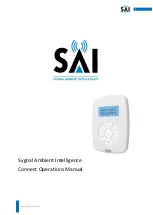
4.1-
4.2-
PROTECTIONS AGAINST ELECTRIC HAZARD
The device is protected against electric hazard due to direct and indirect contacts.
The protection measures against direct contacts aim at protecting people against
hazards due to contact with active parts, usually live parts; while the protection
measures against indirect contacts aim at protecting people against hazards due to
conducing part, which are usually insulated, but could become live in case of failure
(insulation failure).
The adopted protection measures are the following:
1)
Insulation of live parts by means of a plastic material body;
2)
Enclosure with suitable protection degree;
3)
Protection of passive type given by the use of components with double insulation,
also called components of class II or with equivalent insulation (it is forbidden to
perform the connection to the earthing plant of the devices equipped with double
insulation).
RESIDUAL RISKS
The device does not have residual risks. The installer and the user are herewith
informed that after the actuators have been installed on the window, the automatic
enabling of the same can accidentally generate the following residual risk:
Residual risk:
Hazard of squashing or dragging of body parts inserted between the movable and the
fix part of the window frame.
Exposure frequency:
Accidental and when the installer or the user decides to perform a wrong voluntary
action.
Severity of the damage:
Light lesions (usually reversible).
Adopted measures:
1) Manual control
(remote control, radio control or push-button): It is compulsory to
verify that near the window there are not persons, animals or things whose safety
may be accidentally jeopardized. During actuator operation, it is compulsory to be in
a safe control position assuring visual control on the window movement.
2) Automatic control
(sensors): It is compulsory to place on the window suitable safety
signals and/or to install a suitable acoustic/light signaller nearby.
10
TF21/44R/T
INSTALLATION AND USE INSTRUCTIONS
4- SAFETY
VER.1.0
REV.07.04











































